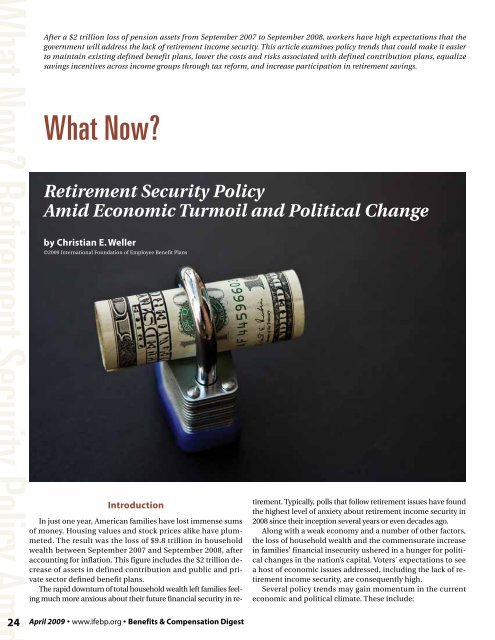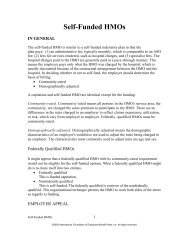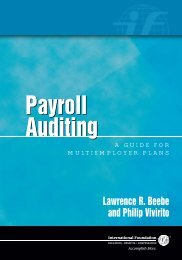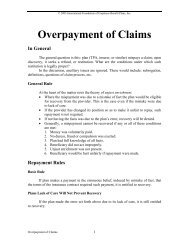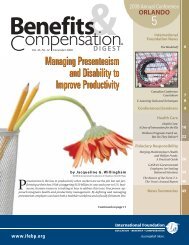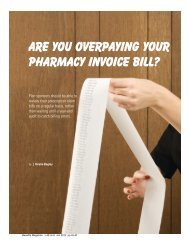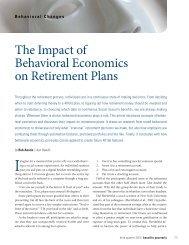Benefits & Compensation Digest, Vol. 46, No. 4, April 2009
Benefits & Compensation Digest, Vol. 46, No. 4, April 2009
Benefits & Compensation Digest, Vol. 46, No. 4, April 2009
- No tags were found...
Create successful ePaper yourself
Turn your PDF publications into a flip-book with our unique Google optimized e-Paper software.
After a $2 trillion loss of pension assets from September 2007 to September 2008, workers have high expectations that thegovernment will address the lack of retirement income security. This article examines policy trends that could make it easierto maintain existing defined benefit plans, lower the costs and risks associated with defined contribution plans, equalizesavings incentives across income groups through tax reform, and increase participation in retirement savings.What <strong>No</strong>w?Retirement Security PolicyAmid Economic Turmoil and Political Changeby Christian E. Weller©<strong>2009</strong> International Foundation of Employee Benefit PlansIntroductionIn just one year, American families have lost immense sumsof money. Housing values and stock prices alike have plummeted.The result was the loss of $9.8 trillion in householdwealth between September 2007 and September 2008, afteraccounting for inflation. This figure includes the $2 trillion decreaseof assets in defined contribution and public and privatesector defined benefit plans.The rapid downturn of total household wealth left families feelingmuch more anxious about their future financial security in retirement.Typically, polls that follow retirement issues have foundthe highest level of anxiety about retirement income security in2008 since their inception several years or even decades ago.Along with a weak economy and a number of other factors,the loss of household wealth and the commensurate increasein families’ financial insecurity ushered in a hunger for politicalchanges in the nation’s capital. Voters’ expectations to seea host of economic issues addressed, including the lack of retirementincome security, are consequently high.Several policy trends may gain momentum in the currenteconomic and political climate. These include:24 <strong>April</strong> <strong>2009</strong> • www.ifebp.org • <strong>Benefits</strong> & <strong>Compensation</strong> <strong>Digest</strong>
• Making it easier for employers tomaintain existing defined benefitplans• Lowering the costs and risks associatedwith defined contributionplans• Equalizing savings incentivesacross income groups through taxreform• Raising retirement savings participationthrough mandates or additionalsavings incentives targeted atunderrepresented groups.The Data Point the Wayfor PolicyWhile families have lost wealth at abreathtaking speed over the past year,Americans’ retirement security was inperil long before the current crisis beganas a result of limited retirement plan coverage,little retirement wealth and increasingindividual risk exposure.Too few people are covered by a retirementsavings plan at work. In 2007,the most recent year for which data areavailable, 45% of private sector workersparticipated in an employer-sponsoredretirement plan. In 2000, 57% participatedin an employer-sponsored plan,according to Bureau of Labor Statisticsdata analyzed by Patrick Purcell at theCongressional Research Service.Purcell’s data analysis shows there islittle difference in coverage trends bygender. But minorities were less likely toparticipate in an employee-sponsoredretirement plan than whites. In 2002, thefirst year for which consistent retirementcoverage data by race and ethnicity areavailable from the Bureau of Labor Statistics’Current Population Survey, nearly59% of white private sector workers participatedin an employer-sponsored retirementplan. In contrast, just 48% ofblack, non-Hispanic workers and 31% ofHispanic workers participated in a plan.Participation rates have been stagnant ordeclined for all three groups by 2007,with 58% of white workers, 47% of black,non-Hispanic workers, and 31% of Hispanicworkers participating in a plan.Participation rates also vary with income.Among workers with earnings inthe lowest quartile, or less than $27,000,less than one-third participated in anemployer-sponsored retirement plan inboth 2000 and 2007, with rates of 32%and 28%, respectively. In 2000, 56% ofprivate sector workers in the third highestearnings quartile participated in anemployer-sponsored retirement plan. In2007, only 50% did. Slightly more thantwo-thirds—67%—of workers in the secondhighest income quartile participatedin an employer-sponsored plan in 2000,but that share dropped to 63% in 2007.And 69% of workers in the highest earningsquartile participated in an employer-sponsoredretirement plan in2007, down from 76% in 2000.Additionally, employer size matters. Purcell,for instance, finds that only 29% of employeesworking for an employer with fewerthan 25 employees had access to an employer-sponsoredretirement plan. The proportionhad declined to only 26% of all employeesat such businesses in 2007. InAmericans’ retirementsecurity was in perillong before the current crisisbegan as a result of limitedretirement plan coverage,little retirement wealthand increasing individualrisk exposure.comparison, 75% of employees at largefirms—those with more than 100 employees—hadaccess to a plan and 65% participatedin one in 2007. Researchers at theInvestment Company Institute, however,concluded that small employers withhigher income and older workers were justas likely as larger employers to offer a retirementplan, and their employees werealso just as likely as those working for largeremployers to participate in such plans.There is also the issue of how much iscontributed to a retirement plan. Analysesof retirement wealth data, such as thatfrom the Center for Retirement Research’sNational Retirement Risk Index or NewYork University economics professor EdwardWolff’s analyses for the EconomicContinued on next pagepensions—AdditionalResourcesMore InformationFor related article summaries, see www.ifebp.org/RetirementSecurityPolicy.Got a specific benefits question?[!] Need some help answering it?Call (888) 334-3327, option 5, andget a prompt e-mail or fax back.Conferences and SeminarsE-Learning CoursesDefined Benefit PlansDefined Contribution PlansFor more information, view www.ifebp.org/elearning.BookRetirement Plans: 401(k)s, IRAs and OtherDeferred <strong>Compensation</strong> ApproachesEverett T. Allen Jr., Joseph J. Melone,Jerry S. Rosenbloom and Dennis F. Mahoney.McGraw Hill. 624 pages. Item#8736. $166.75 (I.F. Members $158.75).For details, view www.ifebp.org/books.asp?8736.To order, call (888) 334-3327, option 4.Pensions ▼<strong>April</strong> <strong>2009</strong> • www.ifebp.org • <strong>Benefits</strong> & <strong>Compensation</strong> <strong>Digest</strong> 25
Policy Institute, show that lower incomeand minority families tend to have less retirementwealth accumulated, relative totheir income, by the time they reach retirement.The primary cause—smaller contributionsover their working life.These data point in the direction forpolicy. To make a substantial dent in retirementsavings participation, publicpolicy needs to focus on small employers.There also must be a clear understandingthat a new approach to increasingparticipation in retirement savingsplans is necessary. Otherwise, more retirementplans may be offered, but moreemployees may not actually participate.The Public Is WorriedAbout Retirement Securityand Wants ActionPublic opinion polling data indicatethat people have become increasinglyworried about their retirement as theeconomy and financial markets weakened.Gallup, for instance, has pollednonretirees about whether they expect tohave enough money to live comfortablyin retirement. The share of respondentswho said they expect to have enoughmoney for a comfortable retirement heldsteady at 59% from 2002 through 2004,before eventually dropping to <strong>46</strong>% in<strong>April</strong> 2008. The 2008 Gallup poll alsofound that the proportion (63%) of nonretireesworried they will not have enoughmoney for their retirement was higherthan both the share of those who wereworried about their ability to pay for medicalcosts associated with an accident orserious illness (56%) and the share whofeared that they would not be able tomaintain their current standard of livingamid 2008’s economic troubles (55%).Retirement security remained an importantissue on Americans’ mindsthroughout the election year of 2008. AMarch-<strong>April</strong> 2008 CBS News/New YorkTimes poll showed that while paying everydaybills was the public’s top personaleconomic concern, saving for retirementwas the second largest concern. Additionally,an August 2008 poll for GeorgeWashington University found that thepublic viewed retirement as a more importantissue for Congress to addressthan the mortgage crisis, taxes or education.These figures indicate that familiesare worried about declining retirementsecurity and want policy makers to dosomething about it.First Policy Direction:Make It Easier for Employersto Maintain TheirDefined Benefit PlansThere are several ways policy makersmay address the decline in retirementsecurity. A discussion about making iteasier for employers to maintain theirexisting defined benefit (DB) plans willprobably occur first. In December 2008,Congress passed and President Bushsigned the Worker, Retiree, and EmployerRecovery Act of 2008 to providepension funding relief to employers thatsponsor DB pension plans in the privatesector.Discussion of this issue may resurface,depending on financial markettrends. Policy makers may require employersto make more contributions toDB pensions in the future in exchangefor relief in the present. Two alternativeapproaches are available to accomplishthis. First, policy makers could require aminimum employer contribution to existingDB plans, as is already the case insome states and being considered in others.Second, funding rules for DB planscould allow for more smoothing of assetand liability values. This would reducethe procyclicality of existing pensionfunding rules in the private sector. Currently,funding rules require larger contributionsduring bad economic timesand lower required contributions duringgood times. An alternative set of fundingrules would thus shift the funding burdenfrom the bad to the good economictimes without lowering benefit security.For example, employers might be allowedto smooth pension plan assetsand liabilities over 20 years. Employersmight also be required to contribute upto a specific level of assets above liabilities,for example, 120%. 1, 2Second Policy Direction:Improving WealthAccumulation in DefinedContribution PlansTwo separate proposals to improvewealth accumulation in individual accountshave gained traction in recentyears. The first would increase coverageby individual accounts. The secondwould reduce the costs and, to some degree,the risks associated with these accounts.Both proposals challenge the existingmodel of voluntary employerparticipation and reliance on marketproducts.Defined contribution (DC) plans oftenrequire employees to enroll themselvesand then make difficult decisionsabout how much to save and where todirect investments. In passing the PensionProtection Act of 2006, Congress attemptedto make automatic enrollmentand efficient asset allocation easier. It istoo soon to reach conclusions about thelaw’s effectiveness on increasing automaticenrollment in DC plans. However,early figures show that automatic enrollmentis a feature of a growing share inDC plans. A 2008 survey by Hewitt AssociatesLLC showed that 44% of respondingfirms offered automatic enrollmentand 30% of the rest were considering implementingit in 2008. A study in thesame year by Deloitte reported that 42%of survey respondents offered automaticenrollment, up from 23% just a year earlier.Policy makers are not content withwaiting for new evidence to emerge withrespect to the impact of past policychanges. After all, the automatic enrollmentfeatures that were passed with thePension Protection Act of 2006 affectonly employers that either already offereda qualified retirement savings planor who plan on offering one soon.Policy makers are considering addedincentives for employers to offer access toqualified plans. An example is the “automaticIRA” proposal requiring every employerwith ten or more employees to offerthe opportunity of automatic payrolldeductions into designated IRAs. To increaseparticipation, Mark Iwry of theBrookings Institution and David John ofthe Heritage Foundation suggested in2006 that this program could be coupledwith automatic enrollment. This proposalfundamentally changes the existingframework of voluntary employer participationby combining the widely acceptedidea of moving toward more automaticsolutions with a minimal requirement onemployers to offer increased access to retirementsavings vehicles.Another proposal that could fundamentallychange the world of retirement26 <strong>April</strong> <strong>2009</strong> • www.ifebp.org • <strong>Benefits</strong> & <strong>Compensation</strong> <strong>Digest</strong>
Pensions ▼[Four separate policy directionscould gain traction with a new administrationand a newly constituted Congressin <strong>2009</strong> and thereafter. First, employershave already asked for somerelief with their pension plans. Policymakers may take this opportunity tonegotiate with employers over ways tomake contributions to pension plansmore regular. Second, policy makersare looking at new ways to improve thewealth accumulation in DC plans, eitherby mandating that employers atleast offer the option of direct depositsinto IRAs or by creating publicly administeredand privately managed lowcost,low-risk investment options forprivate sector employers. Third, theObama administration and the newCongress will have to take up the issueof tax reform, as many tax changes enactedafter 2000 will expire in the comingyears. In all likelihood, this reformdiscussion will include considerationsto provide more saving incentives forlower income and moderate incomeworkers. Fourth, throughout 2008, severalhigh-profile policy proposals haveraised the issue of universal employerand employee contributions, typicallywith a possibility to opt out.Several themes underlie these proposals.First, there is a yearning for lessrisk and more security for employees,either by maintaining existing DB plansor by reducing risk exposure in DCplans. Second, policy makers are movingbeyond pure market-based approachesto encourage lower cost savingoptions. Finally, policy makers atthe state and federal level are beginningto question the wisdom of entirely voluntaryemployer participation. The financialand economic crisis thus couldturn into a serious challenge to the existingretirement saving system in theUnited States, which holds the real possibilityof vastly improving retirementincome security for millions of workersin the future.B&C[Endnotes1. C. Weller, M. Price and D. Margolis, “RewardingHard Work: Give Pennsylvanians a Shotat Middle Class Retirement,” Washington, D.C.:Center for American Progress, 2006, www.americanprogress.org/issues/2006/10/pa_pension_report.html/pdf/pa_pensions_report.pdf.2. Christian E. Weller and Dean Baker,“Smoothing the Waves of Pension Funding:Could Changes in Funding Rules Help AvoidCyclical Under-funding?,” Journal of Policy Reform,pp. 131-151, Summer 2005.3. Christian E. Weller and Shana Jenkins,“Building 401(k) Wealth One Percent at a Time:Fees Chip Away at People’s Retirement NestEgg,” CAP Economic Policy Report, Washington,D.C.: Center for American Progress (March2007), www.americanprogress.org/issues/2007/03/pdf/401k_report.pdf.For information on ordering reprints ofthis article, call (888) 334-3327, option 4.Christian E. Weller, Ph.D., is an associate professor in theDepartment of Public Policy and Public Affairs at the Universityof Massachusetts–Boston and a senior fellow at theCenter for American Progress in Washington, D.C. Weller isalso a research scholar at the Political Economy ResearchInstitute at the University of Massachusetts–Amherst, wherehe earned his Ph.D. degree in economics, and is a researchassociate at the Economic Policy Institute. He previouslyworked at the Center for European Integration Studies atthe University of Bonn in Germany.[[We invite you to share the wealthof your experience and expertisewith our readers. Considersubmitting an article on employeebenefits or compensation topics.<strong>Benefits</strong> & <strong>Compensation</strong> <strong>Digest</strong>welcomes articles of 3,000 words.Calling All Writers . . .Direct your submissions tosenior editor Chris Vogel atchrisv@ifebp.org.We are always on the lookout fortimely articles for our publications.<strong>April</strong> <strong>2009</strong> • www.ifebp.org • <strong>Benefits</strong> & <strong>Compensation</strong> <strong>Digest</strong> 29


